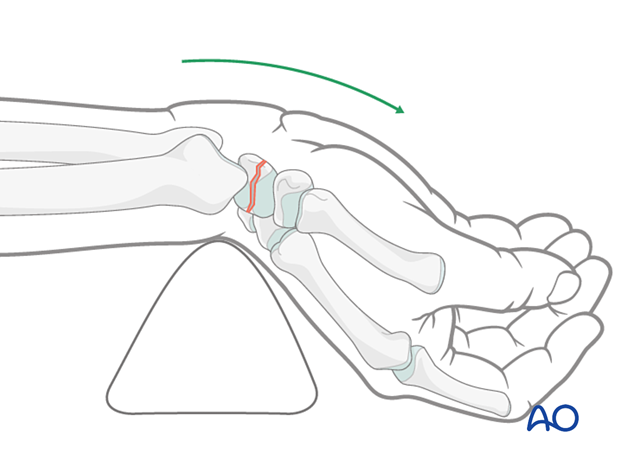ORIF - Palmar plating
1. General considerations
Indications
For the fixation of comminuted scaphoid waist fractures, plating may be used. Another indication is delayed presentation with bone resorption.

Fracture displacement forces
In displaced fractures of the waist of the scaphoid, the distal pole tends to rotate into flexion in relation to the proximal pole, the lunate, and the triquetrum, which lie in extension. This can create a rotational and angular deformity at the fracture site – the so-called “humpback deformity.”

Imaging
Conventional radiographs do not adequately demonstrate the complete fracture configuration. A CT scan is recommended to reveal the degree of displacement.
2. Patient preparation
The patient is usually supine with the arm on a radiolucent side table.

The wrist is extended with the help of a towel to allow for better exposure of the scaphoid.

3. Approach
The palmar approach to the scaphoid gives access to displaced waist fractures that cannot be reduced and fixed by percutaneous techniques.

4. Reduction
Identifying the fracture
In delayed treatment, the fracture is not always obvious. Look for a wrinkle in the articular cartilage.
In these cases, distract, extend, and deviate the wrist towards the ulna to expose the fracture line. Remove any interposed soft tissues and loose bone fragments and irrigate the fracture site.

Reduction
If the fracture cannot be reduced with forceps, insert a K-wire into each main fragment and use the wires as joysticks to manipulate the fragments.
After reduction, make sure that there is no rotational deformity with an image intensifier.

To gain a better view and support the reduction, gently expose the radial aspect of the scaphoid using a small elevator between the scaphoid and styloid process of the radius.

Temporary K-wire fixation
Insert a K-wire provisionally to stabilize the fragments and to maintain rotational alignment during drilling and tapping.
When inserting the K-wire, be careful not to conflict with the planned plate application.

5. Fractures with a defect: adding bone graft
In the case of fracture comminution, particularly with compromise of the palmar cortex, or a defect after removal of loose fragments, autogenous, cancellous bone graft is necessary.

6. Plate fixation
Plating principles
Plating of a multifragmentary scaphoid fracture follows the principles of bridge plating.
The scaphoid plate is available anatomically precontoured with variable-angle locking head screws (1.5 mm).

Plate application
Apply the plate to the bone.
Temporarily fix the plate with two 1.0 mm K-wires to each main fragment.
Check plate position in two views with image intensification.

Screw insertion
Manually insert three VA self-drilling screws in both main fragments.
Select screw tracks so they will not penetrate through the dorsal scaphoid cortex or into the scaphoradial or scaphotrapezial joint.

Confirming plate position
Check the final position of the plate and screws and the scaphoid stability using image intensification.

Case
Perioperative AP and lateral view showing an adequate position of the plate and screws

7. Aftercare
The aftercare can be divided into four phases of healing:
- Inflammatory phase (week 1–3)
- Early repair phase (week 4–6)
- Late repair and early tissue remodeling phase (week 7–12)
- Remodeling and reintegration phase (week 13 onwards)
Full details on each phase can be found here.
Pain control
To facilitate rehabilitation, it is important to control the postoperative pain adequately.
- Management of swelling
- Appropriate splintage
- Appropriate oral analgesia
- Careful consideration of peripheral nerve blockade
Immediate postoperative treatment
Immobilize the wrist with a well-padded below-elbow splint for 6 weeks as the radioscaphocapitate ligament may require a longer healing time.
Splinting helps with soft-tissue healing, especially of the ligaments cut during a palmar approach.













